Some places sound exotic for the palm trees or the culture foreign to our own or for simply how long it takes to get there. Zagreb sounded exotic to us for very different reasons. Most of the times we had heard of this city, Croatia’s capital, was in news reports from the Balkan wars of the early 90’s.
For more than half of our lives, this was a communist country. It’s hard to forget that. Yugoslavia, we were taught, was a socialist backwater that produced very bad automobiles and not much else. Then, after a few years in the power vacuum that followed the death of Marshall Tito, the states that made up Yugoslavia began to decide they didn’t need each other. And for that matter, they didn’t really like each other that much.
We had planned to visit these parts in our travels last year; we wound up spending more time in Turkey instead. It was a must-see this time around, even though the news reports would have you believe the place was overrun with Syrian refugees (we’ve seen none, by the way). The Aegean coast of Croatia and Montenegro and the snowy slopes of Slovenia topped our Balkan wish list. Zagreb is a convenient transportation hub: we flew in from Munich. Many flights coming and going, and many overnight trains coming and going, arrive or depart here. We asked travel friends who had been to Zagreb before what they thought of it.
“There’s not much there,” was the short answer.
Still, we spent 5 days in Zagreb. Our friends were right: so far as a city of sights to see and things to do, Zagreb would disappoint. But what we found was an inexpensive launching point to the Dalmatian coast of Croatia and Montenegro and a very friendly people eager to welcome us to their city.
“Go ahead, ask me anything about Zagreb or Croatia,” our taxi driver challenged us in his endearing accent (it sounds unmistakably Russian to us Americans, but don’t tell them that). We had just landed—a couple of hours late—at the Zagreb airport. We’ve never gotten such an offer from a taxi driver. Lori and I exchanged glances, trying to come up with a question. In our delay, he started volunteering information. “The population of Zagreb is 800,000. This building on the right is the main concert hall. There is a very nice park…”
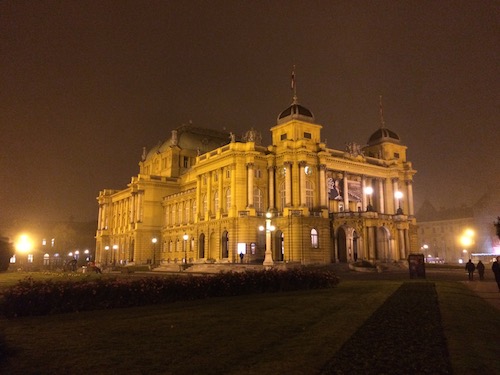
The Croatian National Theatre, Great Architecture
“Did the war affect Zagreb?” was my question. Despite that this region has been a tinderbox for a number of wars through the centuries, nobody today needs to explain what war they now refer to.
He shook his head. “No, not really,” he says at first, but then adds, “there was some shelling.” The people here don’t like to talk much about the war, other than to say it was “stupid”, the frank assessment of another driver we’d have. “Your apartment is in a very nice neighborhood,” he said to change the subject.
That neighborhood I would describe as “soviet” or “bleak”. Seemingly endless rows of plain concrete 4-story buildings illuminated with ugly mercury vapor streetlights hung over the street between them. But it was situated close to Zagreb’s Old Town. And it was an AirBnB apartment of about 1,000 square feet. And it cost all of $45 a night—a splurge, actually, for much of our visit to the Balkans.
The mother of the AirBnB owner met us there. Like the taxi driver, she was endlessly eager to welcome us to her city. She carried one of our bags up to the 3rd floor (by American counting1). She showed us around the apartment, demonstrating how to turn on the television and open the windows and how to fire up the stove. Then she sat down at the kitchen table with us and a map of the city. She looked to be in her 60’s, old enough to have been born into communist Yugoslavia and to have lived through the fall of the Iron Curtain and “the wars” (they were actually a series of sad, stupid conflicts filled with the sort of war crimes and atrocities that only cultural, ethnic, and religious hate can stir up). From her we learned where the important things to see were, that things are no better nor no worse than they used to be (just different), and that Croatia is an overwhelmingly Catholic country. She spent so much time with us that her son called her twice, admonishing–we imagined–her to leave us alone. We enjoyed chatting with her.
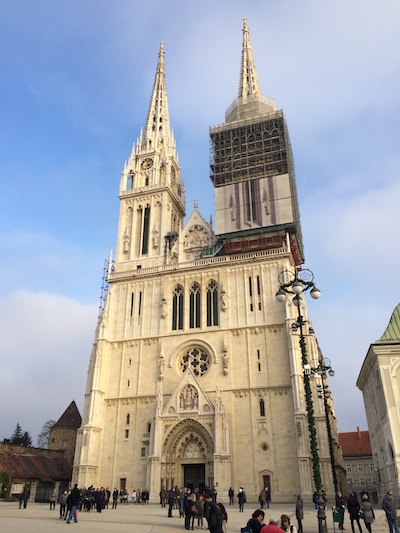

Top: The Zagreb Cathedral. Bottom: Cathedral wall in ancient Croatian alphabet
While there indeed wasn’t much for the tourist itinerary in Zagreb, we enjoyed our time there. They have a splendid cathedral (if you see it, don’t miss the wall covered with writing in the ancient Croatian alphabet). The picturesque little St. Mark’s church with its colored tile roof. The old town on the side of a hill overlooking an expanse of concrete buildings with television antennas and satellite dishes and laundry. Some fascinating architecture from before the era of Yugoslavia if you look for it. And if you go during the season of Advent, as we did, you’ll be treated to an ongoing Christmas market.
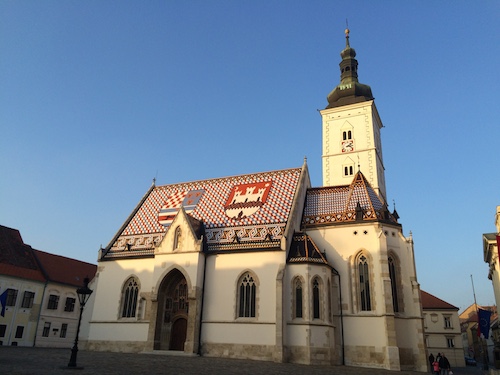
St. Mark’s Church

Croatian storyteller Petrica Kerempuh singing to two murdered colleagues, just before his own demise (notice the noose around his neck?)
While the friendly, eager people are the best thing about Zagreb, the second best thing is the food and drink. There’s an Italian influence on much of the culture, particularly the cuisine. Grilled meats and sausages are particularly good here. You can have a counter lunch for two for the equivalent of $5 or so; a fine dining experience with appetizers and a bottle of wine and desert (try the štrukli) might run you $25. The wine is local and very, very good, and there are seemingly more labels of beer here than in all of the rest of Europe and they all stand toe-to-toe with the beers of Germany, the Czech Republic, and Belgium.
But still, when you’re sitting in a bar or café and the guy sitting next to you looks to be about 50—our age—you can’t help but wonder if he fought in those stupid wars.
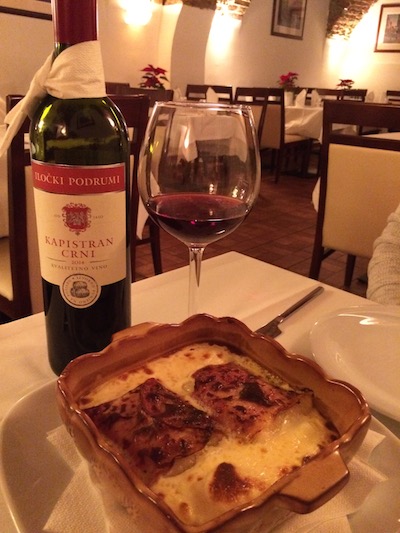
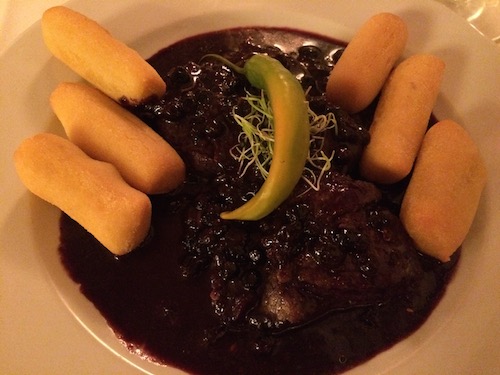
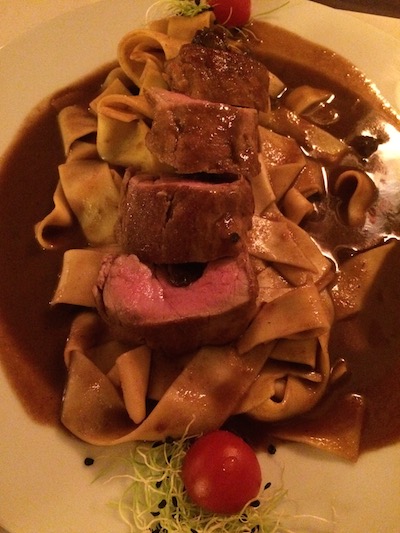
Our $25 Zagreb fine dining experience. Top: wine & appetizer. Middle: Chuck’s entree. Bottom: Lori’s entree.
Footnotes
1 – In case you didn’t know this, Europeans count the floors of their buildings differently than Americans. The bottom floor is “ground” or “zero”; one floor up from that is the “first” floor, what we would call the second floor. So if a European tells you “it’s on the second floor”, by American reckoning that’s the third floor.






